from ESPN http://ift.tt/1dPqUAn
Cassini Looks Out from Saturn
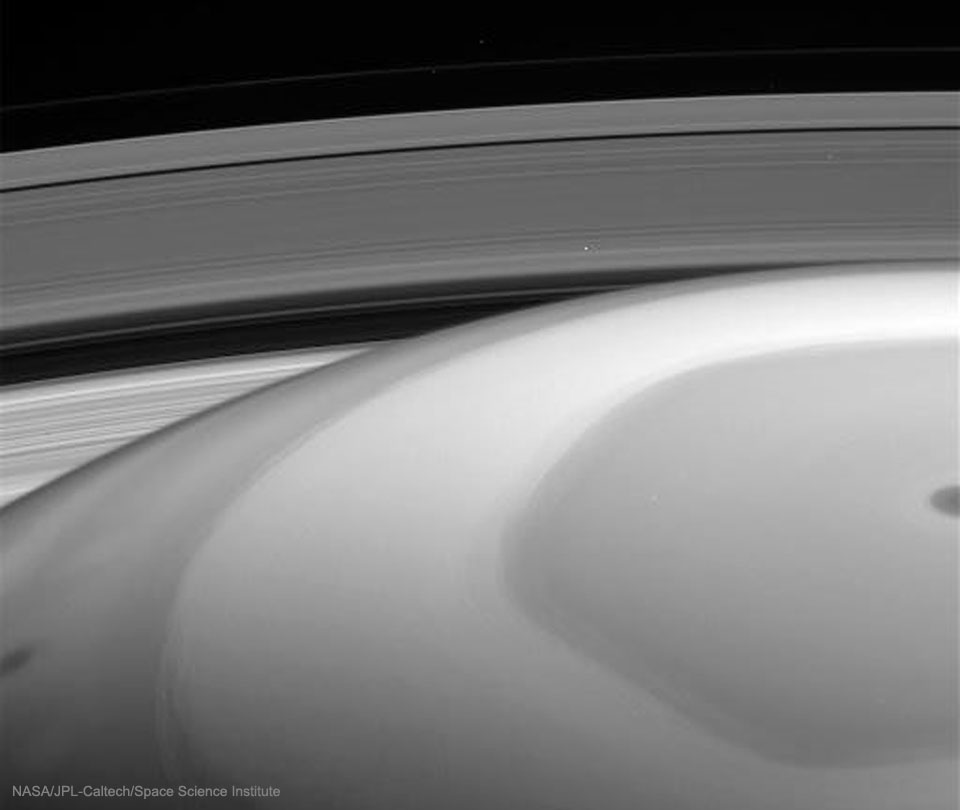
This is what Saturn looks like from inside the rings. Last week, for the first time, NASA directed the Cassini spacecraft to swoop between Saturn and its rings. During the dive, the robotic spacecraft took hundreds of images showing unprecedented detail for structures in Saturn's atmosphere. Looking back out, however, the spacecraft was also able to capture impressive vistas. In the featured image taken a few hours before closest approach, Saturn's unusual northern hexagon is seen surrounding the North Pole. Saturn's C ring is the closest visible, while the dark Cassini Division separates the inner B ring from the outer A. A close inspection will find the two small moons that shepherd the F-ring, the farthest ring discernable. This image is raw and will be officially verified, calibrated and released at a later date. Cassini remains on schedule to end its mission by plunging into Saturn's atmosphere on September 15. via NASA http://ift.tt/2oRAspc
Final: Padres 12 Giants 4. WP: SD J Chacin (3-3) LP: SF C Stratton (ESPN)
from ESPN http://ift.tt/1dPqUAn
Arches of Spring
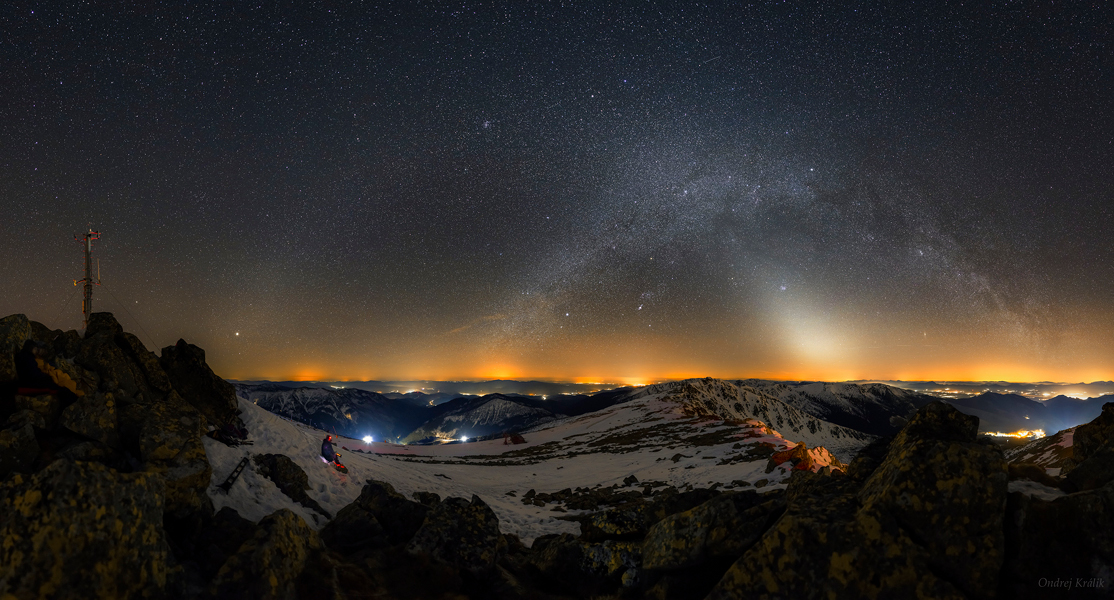
Two luminous arches stretched across the dome of the sky on this northern spring night. After sunset on March 29, the mountain view panorama was captured in 57 exposures from Chopok peak in central Slovakia at an altitude of about 2,000 meters. The arc of the northern Milky Way is visible toward the right, but only after it reaches above the terrestrial lights from the mountain top perspective. Though dusk has passed, a bright patch of celestial light still hovers near the horizon and fades into a second luminous arch of Zodiacal Light, crossing near the center of the Milky Way. Dust in the ecliptic plane reflects sunlight to create the Zodiacal glow, typically prominent after sunset in clear, dark, skies of the northern spring. Almost opposite the Sun, Jupiter shines brightly near the horizon toward the left. Since Jupiter lies near the ecliptic, it appears within the slight brightening of the Zodiacal band also opposite the Sun called the Gegenschein. via NASA http://ift.tt/2pG0XTC
SLS Engine Section Test Article Loaded on Barge Pegasus

A engine section structural qualification test article for NASA's new rocket, the Space Launch System, is loaded onto the barge Pegasus at the agency's Michoud Assembly Facility in New Orleans. The test article now will make its way from Michoud to NASA's Marshall Space Flight Center in Huntsville, Alabama, for structural loads testing. via NASA http://ift.tt/2qc60YS
Exploring the Antennae
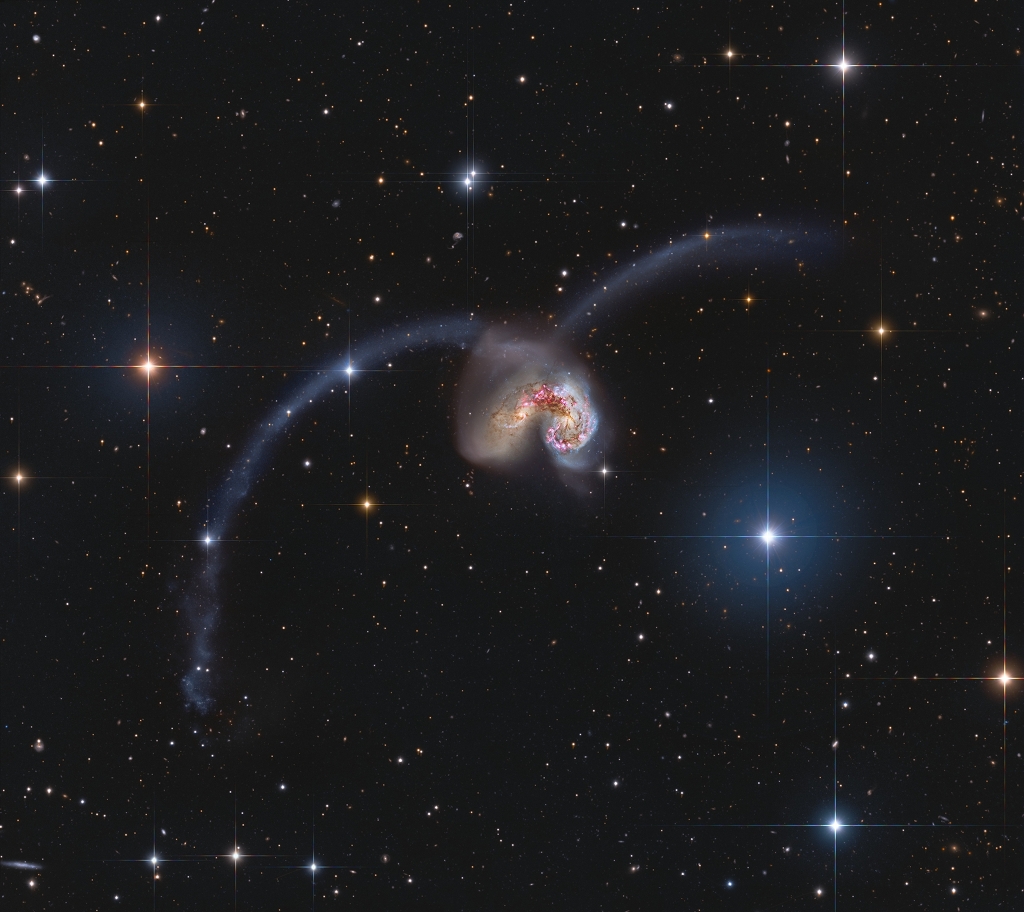
Some 60 million light-years away in the southerly constellation Corvus, two large galaxies are colliding. Stars in the two galaxies, cataloged as NGC 4038 and NGC 4039, very rarely collide in the course of the ponderous cataclysm that lasts for hundreds of millions of years. But the galaxies' large clouds of molecular gas and dust often do, triggering furious episodes of star formation near the center of the cosmic wreckage. Spanning over 500 thousand light-years, this stunning view also reveals new star clusters and matter flung far from the scene of the accident by gravitational tidal forces. The remarkable mosaicked image was constructed using data from the ground-based Subaru telescope to bring out large-scale and faint tidal streams, and Hubble Space Telescope data of extreme detail in the bright cores. The suggestive visual appearance of the extended arcing structures gives the galaxy pair its popular name - The Antennae. via NASA http://ift.tt/2pklrho
F/10: Dodgers 5 Giants 1. WP: LAD K Jansen (1-0) LP: SF C Gearrin (0-1) (ESPN)
from ESPN http://ift.tt/1dPqUAn
Cassini Captures Closest Images of Saturn's Atmosphere

Cassini Captures Closest Images of Saturn's Atmosphere via NASA http://ift.tt/2ozjMHC
F/10: Giants 4 Dodgers 3. WP: SF D Law (2-0) LP: LAD R Stripling (0-2) (ESPN)
from ESPN http://ift.tt/1dPqUAn
Lyrids in Southern Skies
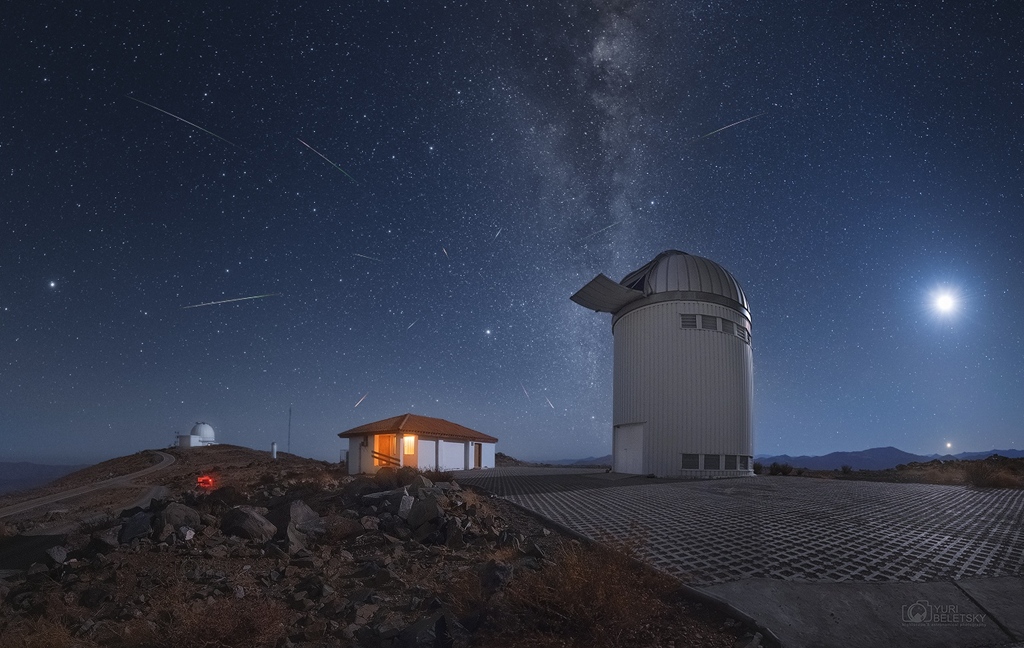
Earth's annual Lyrid meteor shower peaked before dawn on April 22nd, as our fair planet plowed through dust from the tail of long-period comet Thatcher. Seen from the high, dark, and dry Atacama desert a waning crescent Moon and brilliant Venus join Lyrid meteor streaks in this composited view. Captured over 5 hours on the night of April 21/22, the meteors stream away from the shower's radiant, a point not very far on the sky from Vega, alpha star of the constellation Lyra. The radiant effect is due to perspective as the parallel meteor tracks appear to converge in the distance. In the foreground are domes of the Las Campanas Observatory housing (left to right) the 2.5 meter du Pont Telescope and the 1.3 meter Optical Gravitational Lensing Experiment (OGLE) telescope. via NASA http://ift.tt/2p2Mr6N
Giants place Denard Span (collarbone) on DL; Michael Morse called up from Triple-A (ESPN)
from ESPN http://ift.tt/1dPqUAn
Cygnus Spacecraft Approaches Space Station in the Sunset

On Saturday April 22, 2017, Expedition 51 Flight Engineer Thomas Pesquet of the European Space Agency photographed Orbital ATK's Cygnus spacecraft as it approached the International Space Station. Using the station's robotic Canadarm2, Cygnus was successfully captured by Pesquet and Commander Peggy Whitson at 6:05 a.m. EDT Saturday morning. via NASA http://ift.tt/2qf1WWY
Mt. Etna Lava Plume
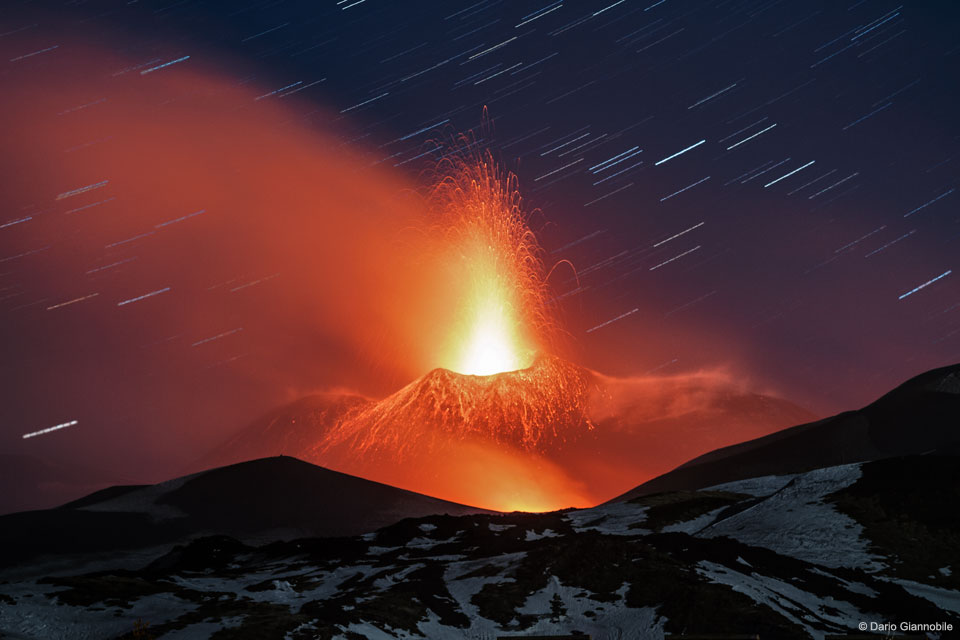
Mt. Etna has been erupting for hundreds of thousands of years. Located in Sicily, Italy, the volcano produces lava fountains over one kilometer high. Mt. Etna is not only one of the most active volcanoes on Earth, it is one of the largest, measuring over 50 kilometers at its base and rising nearly 3 kilometers high. Pictured in mid-March, a spectacular lava plume erupts upwards, dangerous molten volcanic bombs fly off to the sides, while hot lava flows down the volcano's exterior. The Earth's rotation is discernable on this carefully time, moon-lit, long duration image as star trails. via NASA http://ift.tt/2oZGTK0
James Webb Space Telescope Mirror Seen in Full Bloom

It's springtime and the deployed primary mirror of NASA's James Webb Space Telescope looks like a spring flower in full bloom. Once launched into space, the Webb telescope’s 18-segmented gold mirror is specially designed to capture infrared light from the first galaxies that formed in the early universe. via NASA http://ift.tt/2oDRs37
A Split Ion Tail for Comet Lovejoy E4
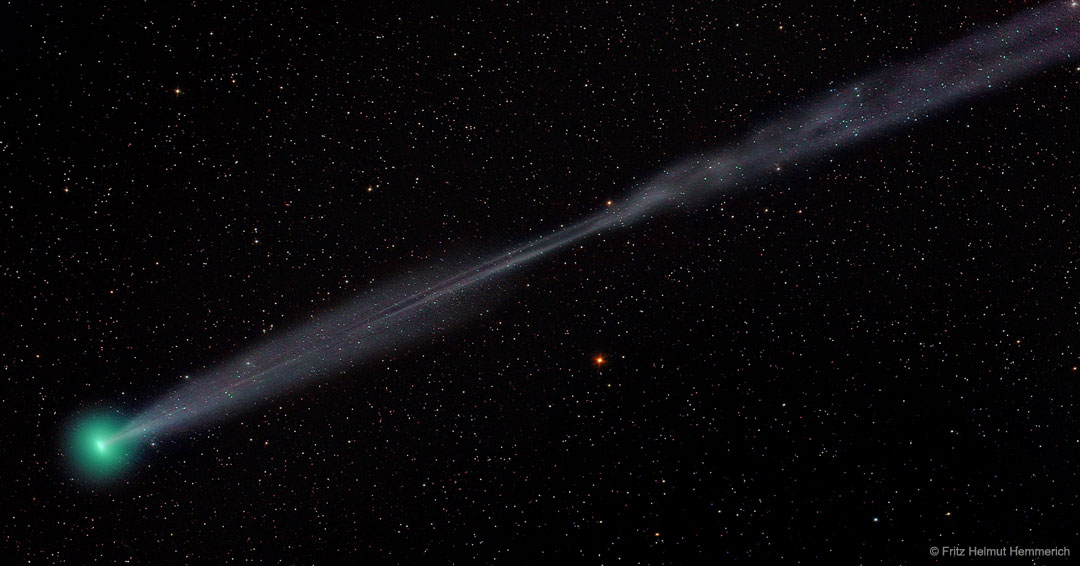
What's happened to Comet Lovejoy? In the pictured image, a processed composite, the comet was captured early this month after brightening unexpectedly and sporting a long and intricate ion tail. Remarkably, the typically complex effect of the Sun's wind and magnetic field here caused the middle of Comet Lovejoy's ion tail to resemble the head of a needle. Comet C/2017 E4 (Lovejoy) was discovered only last month by noted comet discoverer Terry Lovejoy. The comet reached visual magnitude 7 earlier this month, making it a good target for binoculars and long duration exposure cameras. What's happened to Comet Lovejoy (E4) since this image was taken might be considered even more remarkable -- the comet's nucleus appeared to be disintegrating and fading as it neared its closest approach to the Sun two days ago. via NASA http://ift.tt/2p9Ccfd
NASA Astronaut Peggy Whitson Sets Spaceflight Record

534 days, 2 hours, 49 minutes and counting. NASA astronaut Peggy Whitson flew through the standing record for cumulative time spent in space by a U.S. astronaut at 1:27 a.m. EDT on April 24, 2017, and with the recent extension of her stay at the International Space Station, she has five months to rack up a new one. via NASA http://ift.tt/2pcSZQM
Final: Rockies 8 Giants 0. WP: COL K Freeland (2-1) LP: SF J Samardzija (0-4) (ESPN)
from ESPN http://ift.tt/1dPqUAn
Final: Rockies 12 Giants 3. WP: COL A Senzatela (3-0) LP: SF M Moore (1-3) (ESPN)
from ESPN http://ift.tt/1dPqUAn
Madison Bumgarner's injury a punch to the gut for last-place Giants - Jerry Crasnick (ESPN)
from ESPN http://ift.tt/1dPqUAn
NASA's Fleet of Satellites Keep an Eye on Earth

NASA's fleet of 18 Earth science missions in space, supported by aircraft, ships and ground observations, measure aspects of the environment that touch the lives of every person around the world. This visualization shows the NASA fleet in 2017. via NASA http://ift.tt/2plZ9yK
Expedition 51 Launch to the International Space Station

The Soyuz MS-04 rocket launches from the Baikonur Cosmodrome in Kazakhstan on Thursday, April 20, 2017 at 1:13 p.m. Baikonur time carrying NASA astronaut Jack Fischer and cosmonaut Fyodor Yurchikhin of the Russian space agency Roscosmos into orbit to begin their four and a half month mission on the International Space Station. via NASA http://ift.tt/2oq0hxi
Asteroid 2014 JO25
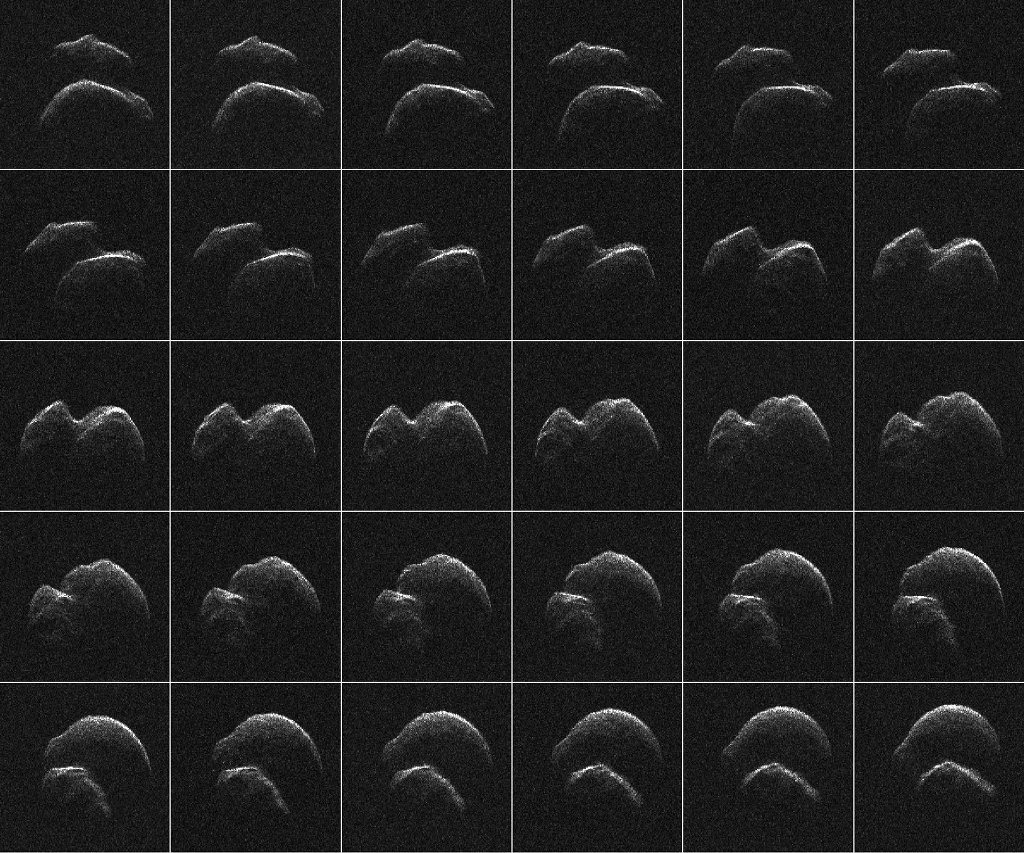
A day before its closest approach, asteroid 2014 JO25 was imaged by radar with the 70-meter antenna of NASA's Goldstone Deep Space Communications Complex in California. This grid of 30 radar images, top left to lower right, reveals the two-lobed shape of the asteroid that rotates about once every five hours. Its largest lobe is about 610 meters across. On the list of Potentially Hazardous Asteroids, this space rock made its close approach to our fair planet on April 19, flying safely past at a distance of 1.8 million kilometers. That's over four times the distance from the Earth to the Moon. The asteroid was a faint and fast moving speck visible in backyard telescopes. Asteroid 2014 JO25 was discovered in May 2014 by the Catalina Sky Survey, a project of NASA's Near-Earth Objects Observations Program in collaboration with the University of Arizona. via NASA http://ift.tt/2oNWfQr
The Arrhythmic Beating of a Black Hole Heart

At the center of the Centaurus galaxy cluster, there is a large elliptical galaxy called NGC 4696. Deeper still, there is a supermassive black hole buried within the core of this galaxy. New data from NASA’s Chandra X-ray Observatory and other telescopes has revealed details about this giant black hole. via NASA http://ift.tt/2oOFlkG
The Red Spider Planetary Nebula
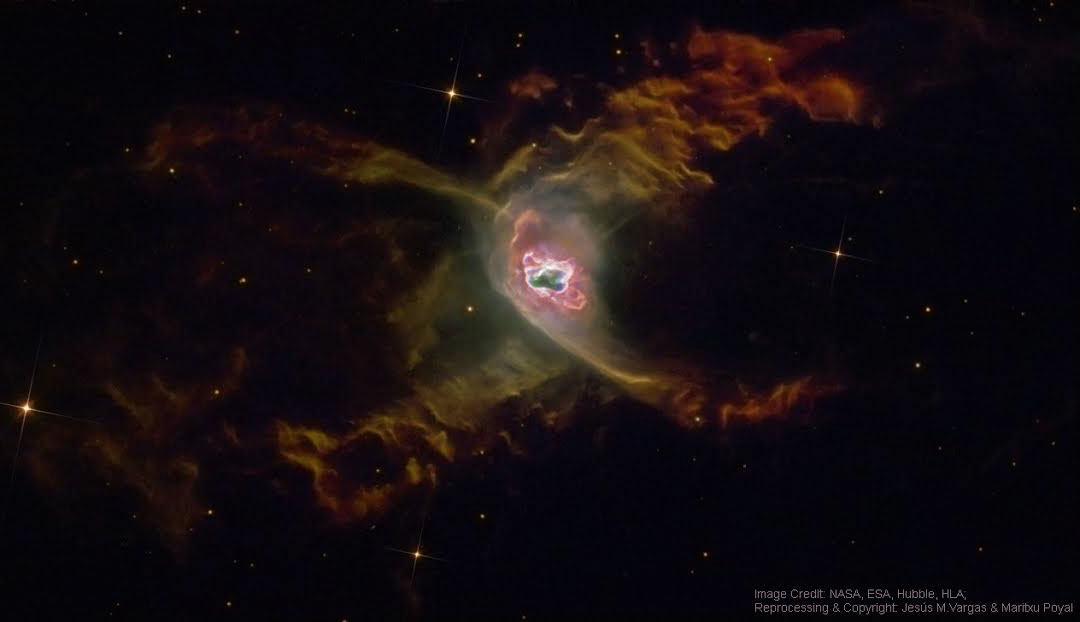
Oh what a tangled web a planetary nebula can weave. The Red Spider Planetary Nebula shows the complex structure that can result when a normal star ejects its outer gases and becomes a white dwarf star. Officially tagged NGC 6537, this two-lobed symmetric planetary nebula houses one of the hottest white dwarfs ever observed, probably as part of a binary star system. Internal winds emanating from the central stars, visible in the center, have been measured in excess of 1000 kilometers per second. These winds expand the nebula, flow along the nebula's walls, and cause waves of hot gas and dust to collide. Atoms caught in these colliding shocks radiate light shown in the above representative-color picture by the Hubble Space Telescope. The Red Spider Nebula lies toward the constellation of the Archer (Sagittarius). Its distance is not well known but has been estimated by some to be about 4,000 light-years. via NASA http://ift.tt/2op0P5F
Giants: Buster Posey (concussion) will return and DH in Tuesday's game vs. Royals (ESPN)
from ESPN http://ift.tt/1dPqUAn
Liftoff of Orbital ATK Cargo Mission to International Space Station

The Orbital ATK Cygnus pressurized cargo module is carried atop the United Launch Alliance Atlas V rocket from Space Launch Complex 41 at Cape Canaveral Air Force Station. Orbital ATK's seventh commercial resupply services mission will deliver 7,600 pounds of supplies, equipment and scientific research materials to the International Space Station. via NASA http://ift.tt/2oq0waK
Watercolor World

When imaged at infrared wavelengths that pierce the planet’s upper haze layer, the high-speed winds of Saturn's atmosphere produce watercolor-like patterns. via NASA http://ift.tt/2pa9Owi
Final: Rockies 5 Giants 0. WP: COL T Chatwood (1-2) LP: SF M Moore (1-2) (ESPN)
from ESPN http://ift.tt/1dPqUAn
Final: Giants 8 Rockies 2. WP: SF J Cueto (3-0) LP: COL T Anderson (1-2) (ESPN)
from ESPN http://ift.tt/1dPqUAn
Hubble Sees Starbursts in Virgo

Starburst galaxies contain regions where stars are forming at such a breakneck rate that the galaxy is eating up its gas supply faster than it can be replenished. via NASA http://ift.tt/2oc4cxm
Illustration of Cassini Spacecraft Diving Through Plume of 'Ocean World' Enceladus

This illustration shows NASA's Cassini spacecraft diving through the plume of Saturn's moon Enceladus, in 2015. Two veteran NASA missions are providing new details about icy, ocean-bearing moons of Jupiter and Saturn, further heightening the scientific interest of these and other "ocean worlds" in our solar system and beyond. via NASA http://ift.tt/2pyf5di
Final: Giants 6 Diamondbacks 2. WP: SF M Cain (1-0) LP: ARI S Miller (1-1) (ESPN)
from ESPN http://ift.tt/1dPqUAn
Moons and Jupiter
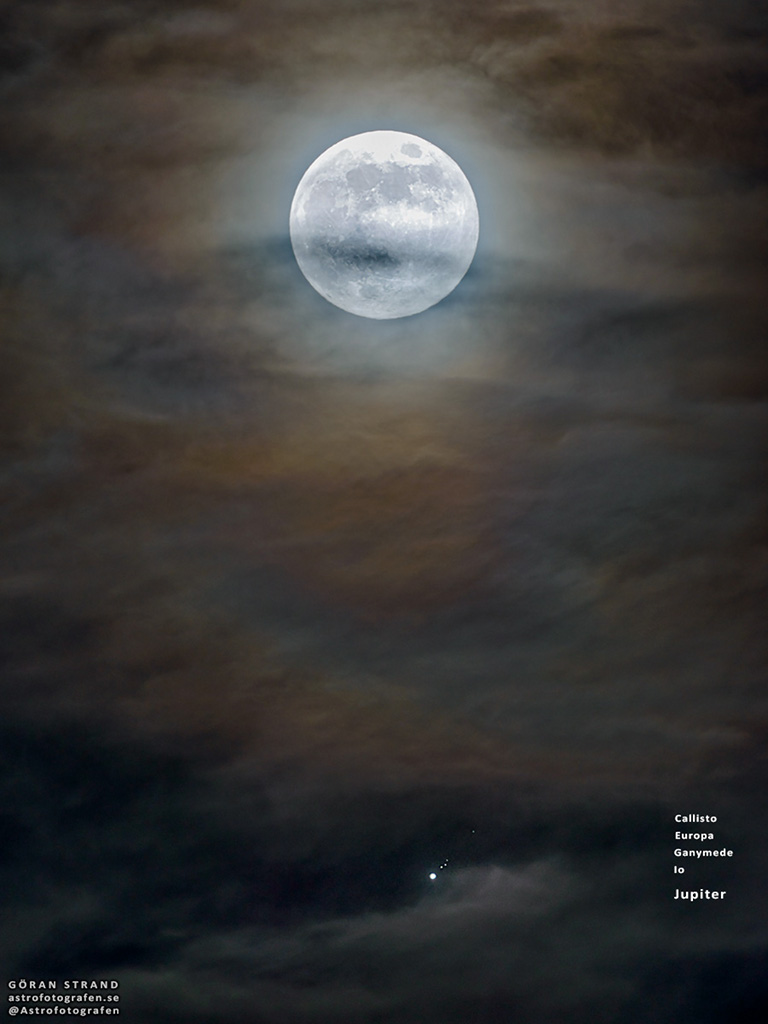
On April 10, a Full Moon and Jupiter shared this telephoto field of view. Both were near opposition, opposite the Sun in Earth's night sky. Captured when a passing cloud bank dimmmed the bright moonlight slightly, the single exposure reveals the familiar face of our fair planet's own large natural satellite, along with a line up of the ruling gas giant's four Galilean moons. Labeled top to bottom, the tiny pinpricks of light above bright Jupiter are Callisto, Europa, Ganymede, and Io. Closer and brighter, our own natural satellite appears to loom large. But Callisto, Ganymede, and Io are physically larger than Earth's Moon, while water world Europa is only slightly smaller. In fact, of the Solar System's six largest planetary satellites, only Saturn's moon Titan is missing from the scene. via NASA http://ift.tt/2prWH5V
New Full-hemisphere Views of Earth at Night

NASA scientists are releasing new global maps of Earth at night, providing the clearest yet composite view of the patterns of human settlement across our planet. This composite image, one of three new full-hemisphere views, provides a view of the Americas at night. via NASA http://ift.tt/2o6PerJ
Leo Trio
This group is popular in the northern spring. Famous as the Leo Triplet, the three magnificent galaxies gather in one field of view. Crowd pleasers when imaged with even modest telescopes, they can be introduced individually as NGC 3628 (left), M66 (bottom right), and M65 (top). All three are large spiral galaxies but they tend to look dissimilar because their galactic disks are tilted at different angles to our line of sight. NGC 3628 is seen edge-on, with obscuring dust lanes cutting across the plane of the galaxy, while the disks of M66 and M65 are both inclined enough to show off their spiral structure. Gravitational interactions between galaxies in the group have also left telltale signs, including the warped and inflated disk of NGC 3628 and the drawn out spiral arms of M66. This gorgeous view of the region spans about one degree (two full moons) on the sky. The field covers over 500 thousand light-years at the trio's estimated distance of 30 million light-years. via NASA http://ift.tt/2p3iAJs
New Technique For Designing and Manufacturing Heat Shields Under Study

Through NASA's Space Technology Research Fellowship (NSTRF) program, a fresh approach to designing and manufacturing heat-thwarting thermal protection systems - or heatshields - for spacecraft is being developed and tested, offering the promise of fabricating larger tile sizes while reducing labor, cost and waste. via NASA http://ift.tt/2p2cknX
Man, Dog, Sun
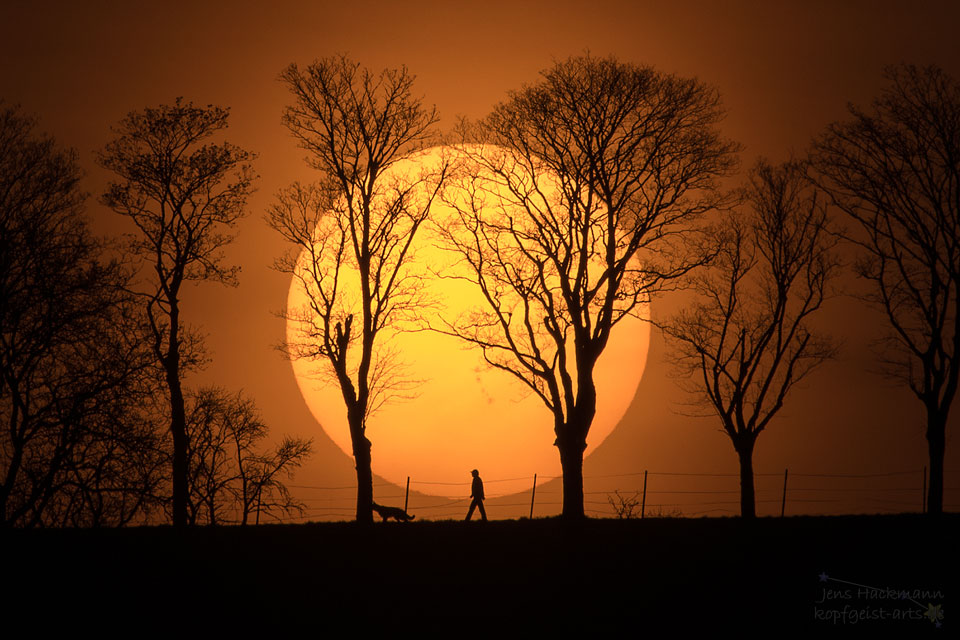
This was supposed to be a shot of trees in front of a setting Sun. Sometimes, though, the unexpected can be photogenic. During some planning shots, a man walking his dog unexpected crossed the ridge. The result was so striking that, after cropping, it became the main shot. The reason the Sun appears so large is that the image was taken from about a kilometer away through a telephoto lens. Scattering of blue light by the Earth's atmosphere makes the bottom of the Sun appear slightly more red that the top. Also, if you look closely at the Sun, just above the man's head, a large group of sunspots is visible. The image was taken just last week in Bad Mergentheim, Germany. via NASA http://ift.tt/2nw42oh
Expedition 50 Soyuz MS-02 Landing

The Soyuz MS-02 spacecraft is seen as it lands with Expedition 50 Commander Shane Kimbrough of NASA and Flight Engineers Sergey Ryzhikov and Andrey Borisenko of Roscosmos near the town of Zhezkazgan, Kazakhstan on Monday, April 10, 2017 (Kazakh time). via NASA http://ift.tt/2oqwnvB
Galaxy Cluster Gas Creates Hole in Microwave Background
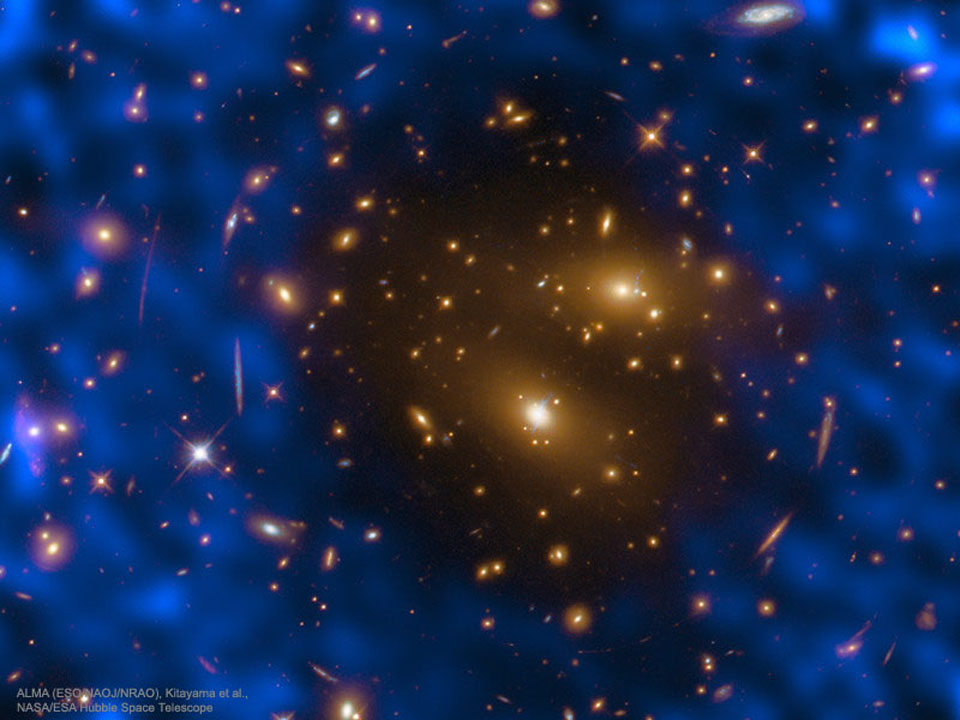
Why would this cluster of galaxy punch a hole in the cosmic microwave background (CMB)? First, the famous CMB was created by cooling gas in the early universe and flies right through most gas and dust in the universe. It is all around us. Large clusters of galaxies have enough gravity to contain very hot gas -- gas hot enough to up-scatter microwave photons into light of significantly higher energy, thereby creating a hole in CMB maps. This Sunyaev–Zel'dovich (SZ) effect has been used for decades to reveal new information about hot gas in clusters and even to help discover galaxy clusters in a simple yet uniform way. Pictured is the most detailed image yet obtained of the SZ effect, now using both ALMA to measure the CMB and the Hubble Space Telescope to measure the galaxies in the massive galaxy cluster RX J1347.5-1145. False-color blue depicts light from the CMB, while almost every yellow object is a galaxy. The shape of the SZ hole indicates not only that hot gas is present in this galaxy cluster, but also that it is distributed in a surprisingly uneven manner. via NASA http://ift.tt/2om8Pbj
Final: Padres 2 Giants 1. WP: SD J Chacin (1-1) LP: SF M Bumgarner (0-1) (ESPN)
from ESPN http://ift.tt/1dPqUAn
Zeta Oph: Runaway Star
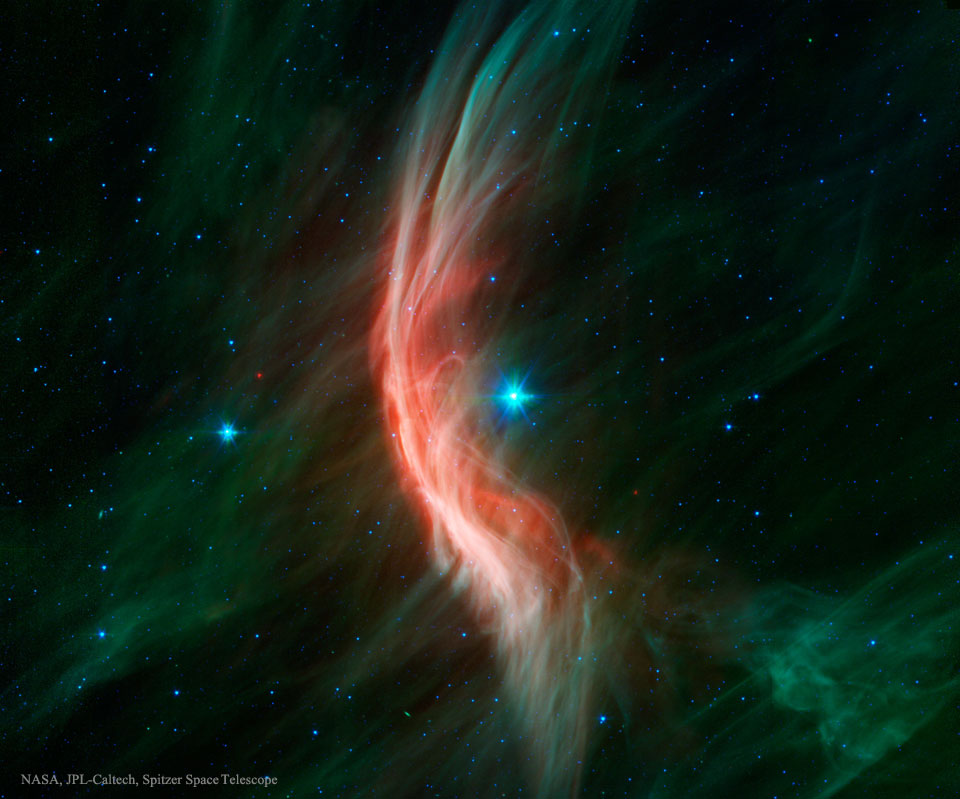
Like a ship plowing through cosmic seas, runaway star Zeta Ophiuchi produces the arcing interstellar bow wave or bow shock seen in this stunning infrared portrait. In the false-color view, bluish Zeta Oph, a star about 20 times more massive than the Sun, lies near the center of the frame, moving toward the left at 24 kilometers per second. Its strong stellar wind precedes it, compressing and heating the dusty interstellar material and shaping the curved shock front. What set this star in motion? Zeta Oph was likely once a member of a binary star system, its companion star was more massive and hence shorter lived. When the companion exploded as a supernova catastrophically losing mass, Zeta Oph was flung out of the system. About 460 light-years away, Zeta Oph is 65,000 times more luminous than the Sun and would be one of the brighter stars in the sky if it weren't surrounded by obscuring dust. The image spans about 1.5 degrees or 12 light-years at the estimated distance of Zeta Ophiuchi. via NASA http://ift.tt/2o860IV
When Jovian Light and Dark Collide

This image, taken by the JunoCam imager on NASA’s Juno spacecraft, highlights a feature on Jupiter where multiple atmospheric conditions appear to collide. via NASA http://ift.tt/2o5rTs1
Final: Diamondbacks 9 Giants 3. WP: ARI J De La Rosa (1-0) LP: SF J Samardzija (0-1) (ESPN)
from ESPN http://ift.tt/1dPqUAn
Interment of John Glenn at Arlington National Cemetery

A horse drawn caisson carries former astronaut and U.S. Senator John Glenn to his final resting place during the interment ceremony at Arlington National Cemetery on Thursday, April 6, 2017, in Virginia. Glenn was the first American to orbit Earth on Feb. 20, 1962, in a five-hour flight aboard the Friendship 7 spacecraft. via NASA http://ift.tt/2oOtUsT
Dark Nebula LDN 1622 and Barnards Loop
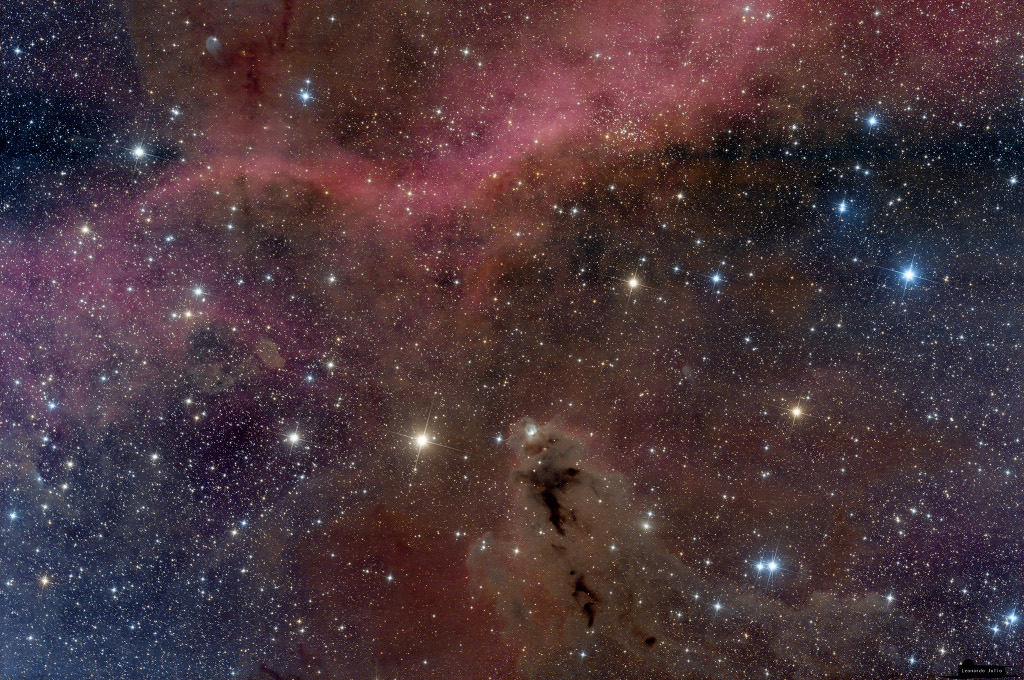
The silhouette of an intriguing dark nebula inhabits this cosmic scene. Lynds' Dark Nebula (LDN) 1622 appears below center against a faint background of glowing hydrogen gas only easily seen in long telescopic exposures of the region. LDN 1622 lies near the plane of our Milky Way Galaxy, close on the sky to Barnard's Loop - a large cloud surrounding the rich complex of emission nebulae found in the Belt and Sword of Orion. Arcs along a segment of Barnard's loop stretch across the top of the frame. But the obscuring dust of LDN 1622 is thought to be much closer than Orion's more famous nebulae, perhaps only 500 light-years away. At that distance, this 1 degree wide field of view would span less than 10 light-years. via NASA http://ift.tt/2naFHUQ
Illustration of Cassini Spacecraft's Grand Finale Dive

This illustration shows NASA's Cassini spacecraft about to make one of its dives between Saturn and its innermost rings as part of the mission's grand finale. Cassini will make 22 orbits that swoop between the rings and the planet before ending its mission on Sept. 15, 2017, with a final plunge into Saturn. via NASA http://ift.tt/2oCWUXh
Final: Giants 8 Diamondbacks 4. WP: SF J Cueto (1-0) LP: ARI P Corbin (0-1) (ESPN)
from ESPN http://ift.tt/1dPqUAn
Giants: Denard Span will miss Tuesday's game at Diamondbacks with sore hip (ESPN)
from ESPN http://ift.tt/1dPqUAn
Space Station View of Auroras

Expedition 50 Flight Engineer Thomas Pesquet of the European Space Agency (ESA) photographed brightly glowing auroras from his vantage point aboard the International Space Station on March 27, 2017. Pesquet wrote, "The view at night recently has been simply magnificent: few clouds, intense auroras. I can’t look away from the windows." via NASA http://ift.tt/2nYJfZv
Sliver of Saturn

Although only a sliver of Saturn's sunlit face is visible in this view, the mighty gas giant planet still dominates the view. via NASA http://ift.tt/2oug9lG
Final: Diamondbacks 6 Giants 5. WP: ARI F Rodney (1-0) LP: SF M Melancon (0-1) (ESPN)
from ESPN http://ift.tt/1dPqUAn
Final: Giants 6 Athletics 3. WP: SF T Beede LP: OAK A Triggs SV: SF R Moronta (ESPN)
from ESPN http://ift.tt/1dPqUAn
Subscribe to:
Posts (Atom)